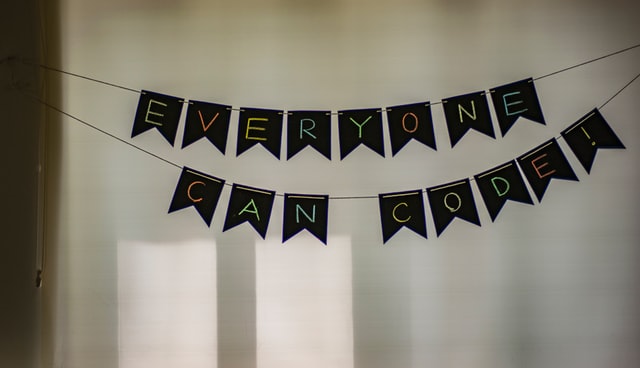We’re creating 2.5 quintillion bytes of data every day in a world where 90% of the total data was generated just within the last two years. That’s a lot of information to curate, store, and soak up — so much so that there simply aren’t enough human minds available to analyze it all. We need students who understand how to use computers to process the data (aka “coding”).
These youngsters need the inquisitive mindset of, “How can computers help us to solve problems?” Here’s how teachers in any subject area (not just computer science) can start teaching coding in their classrooms:
-
Don’t be afraid to get a little “unstructured.” I’m a traditional science teacher who has fish tanks and diagrams all over the classroom, but on coding day we move the chairs and get together as a group. Teachers are used to having structured classrooms, and they usually associate unstructured learning with “play.” In my own class, I wanted coding to be different and special for my students. I wanted them to have that ownership in the classroom, so I asked them how they wanted everything to be set up and where they wanted to sit (e.g., the floor, the teacher’s desk, or at the front of the room). This unstructured approach works well when working with structured material, which in this case is the coding itself.
-
Work from a level playing field. When I started teaching coding, I kicked off the initiative with one clear rule: always be honest. For example, I was very honest with my students about being new to this — having never done it before and not knowing exactly how to start. With the program projected onto the whiteboard, we all learned together. This showed my students that teachers can make mistakes and it’s okay to learn as you go. It tightened up our little community, which embraced the chance to really be a part of the foundational process. When something is meaningful to students, they want to do it even more. It all just kind of builds upon itself.
-
Choose a flexible, easy-to-learn platform. Aim for a Web-based tool that is simple, doesn’t require costly equipment or IT requirements and that is inclusive to everyone in the class. We chose CoderZ and its Cyber Robotics Coding Competition because we felt the fun factor balanced well with the educational value. The fact that students could work in class or at home and that each student had their own coding interface made a big difference. I also liked the onboarding webinars and guidance that was available — making it easy for me to get started.
-
Get one teacher onboard and watch it spread like wildfire. All you need is one teacher to have that commitment to coding. Before you know it, one teacher in one class will rapidly grow into two and then four. The next thing you know it’s the whole grade level and then the entire school that’s taking part in it. How does this happen? It’s simple. Teachers see students all over campus on their computers, always talking about coding and being excited about it, and soon they’ll want to be doing it in their own classrooms.
-
Coding isn’t a solo sport. The way I see it, coding is pretty much new terrain for all of us, so let’s do it together. Taking this stand helps to create a sense of student empowerment, encourages peer-to-peer assistance, and creates a strong sense of community.
We worked with CoderZ to bring its Cyber Robotics Coding Competition into our school. Our students jumped on board and went full out. We started with 20 minutes a week in science classrooms and added coding into the science program. Through a virtual competition, they got to see and interact with students from all over the world on the leaderboard. We went into it to have fun and made it to finals, flew to Virginia knowing that no matter the outcome, we were all getting milkshakes and French fries. Our team wound up winning first place in the South Atlantic Championship. It was a great experience!
Introducing a new program into the classroom can be overwhelming, but it helps to just take small strides. Celebrate the little wins (i.e., “we all successfully logged in”) and watch your program grow from there. Celebrate it, laugh about it and enjoy yourselves. Remember that these are the small achievements that bring peers together and encourage them to help each other instead of just competing against one another.
Stephanie Oster is a STEM Teacher at the Benjamin School in North Palm Beach, Fla. Her school uses CoderZ and participates in the company’s Cyber Robotics Coding Competition.
_____________________________________________________________________________
Like this article? Sign up for Career Tech Update SmartBrief to get news like this in your inbox, or check out all of SmartBrief’s education newsletters, covering career and technical education, educational leadership, math education and more.
